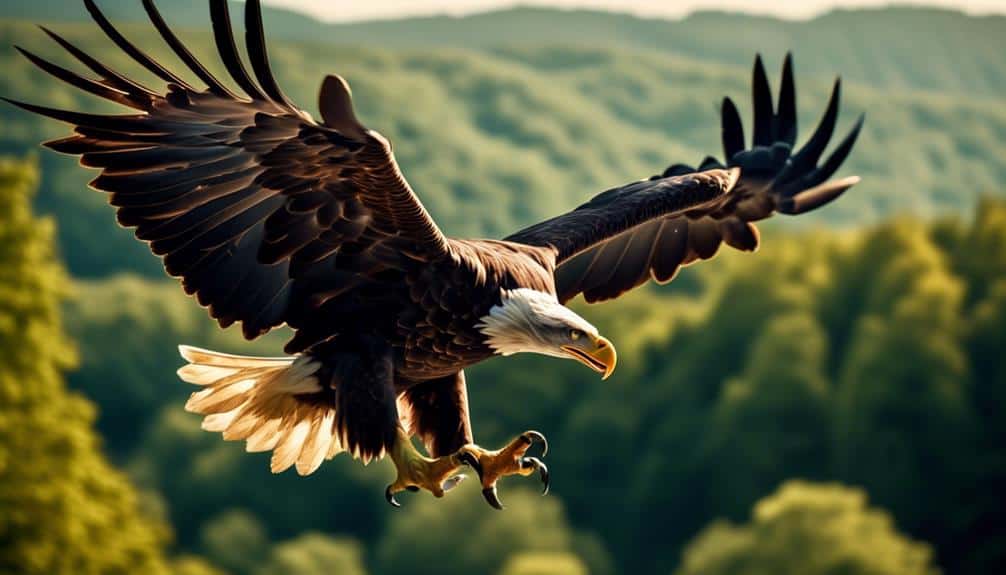As I stood on the edge of the vast Pennsylvania wilderness, a gust of wind rustled through the trees, carrying with it the haunting call of a majestic bird soaring high above.
Pennsylvania is home to a diverse array of birds of prey, each one possessing its own unique characteristics and captivating allure. From the powerful wingspan of the Bald Eagle to the graceful flight of the Red-tailed Hawk, these incredible creatures command our attention and inspire a sense of wonder.
But there is one bird in particular, lurking in the shadows with its keen eyes and silent wings, that has piqued my curiosity. Its name is whispered with reverence among bird enthusiasts – the Peregrine Falcon.
The Majestic Bald Eagle

The majestic Bald Eagle, with its striking white head and tail, is a renowned bird of prey found throughout the state of Pennsylvania. As a top predator in the ecosystem, the ecology of bald eagles is of utmost importance. These birds primarily inhabit areas near large bodies of water, such as rivers and lakes, where they can find an abundant food source of fish. They build their nests, known as eyries, in tall trees near the water, providing them with a strategic vantage point for hunting and protecting their young.
Conservation efforts for bald eagles have been crucial in ensuring their continued existence. In the past, these birds faced significant threats, including habitat loss, pollution, and illegal hunting. However, through extensive conservation measures, such as the banning of harmful pesticides and the protection of nesting sites, the population of bald eagles has made a remarkable recovery. The efforts of organizations like the Pennsylvania Game Commission and the U.S. Fish and Wildlife Service have been instrumental in safeguarding these magnificent birds.
Today, the bald eagle is no longer listed as an endangered species but is still protected under the Bald and Golden Eagle Protection Act and the Migratory Bird Treaty Act. Continued monitoring and conservation efforts are essential to maintain the population and habitat of these iconic birds of prey in Pennsylvania.
The Stealthy Peregrine Falcon
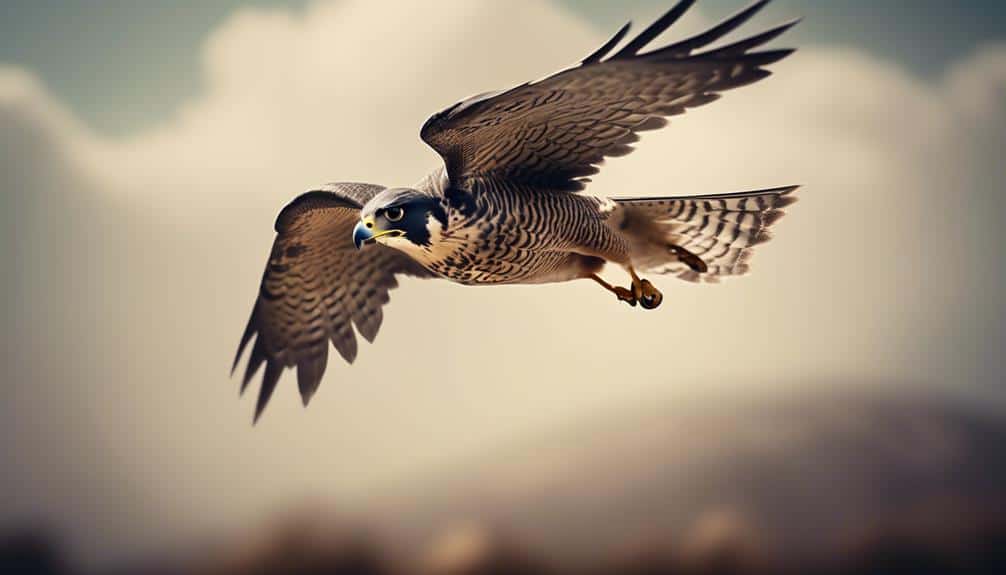
Often soaring through the skies with incredible speed and precision, the peregrine falcon is a stealthy and formidable bird of prey found in Pennsylvania. With its sleek body and long, pointed wings, the peregrine falcon is built for speed and agility. It's widely known for its hunting prowess, employing a variety of techniques to capture its prey.
One of the most remarkable hunting techniques of the peregrine falcon is its ability to stoop. This is when the falcon dives from great heights at speeds that can exceed 240 miles per hour, making it the fastest animal in the world. As it approaches its prey, the falcon tucks its wings and extends its talons, striking with deadly accuracy.
Peregrine falcon conservation efforts have been vital in ensuring the survival of this magnificent species. In the mid-20th century, their populations drastically declined due to the widespread use of pesticides like DDT. These chemicals caused thinning of the eggshells, leading to reproductive failure. However, through dedicated conservation programs and the ban of DDT, peregrine falcons made a remarkable recovery. Today, they're considered a success story in the field of conservation, with their numbers steadily increasing.
The Wise Great Horned Owl
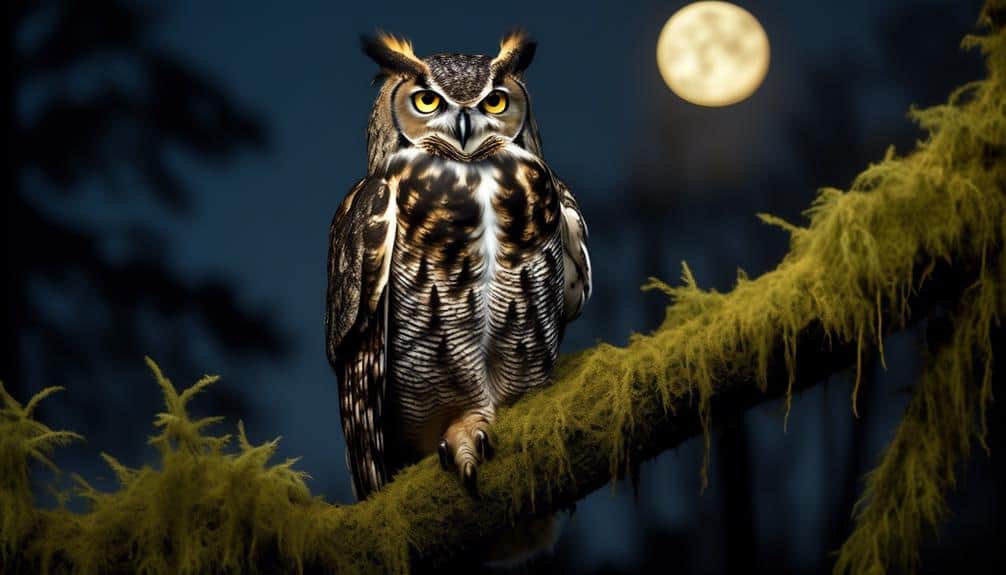
With its large, piercing eyes and distinctive ear tufts, the great horned owl is a formidable and wise bird of prey found in Pennsylvania. This magnificent creature showcases remarkable adaptive behavior and hunting techniques that allow it to thrive in its environment.
The great horned owl is well-known for its exceptional hunting skills. Equipped with sharp talons and a powerful beak, it's capable of capturing a wide variety of prey, including small mammals, birds, reptiles, and even other owls. Its hunting techniques are diverse and adaptable, enabling it to survive in different habitats and climates. This species displays both sit-and-wait and active hunting strategies, depending on the circumstances. When employing the sit-and-wait approach, the owl perches motionless on a high vantage point, patiently scanning the surroundings for potential prey. Once a target is spotted, it swoops down with incredible speed and precision, using its silent flight to ambush its unsuspecting victim.
The great horned owl's adaptive behavior also contributes to its success as a predator. It has a remarkable ability to camouflage itself, blending seamlessly with its surroundings. Its mottled brown feathers provide excellent camouflage in wooded areas, while its white belly feathers help it blend in with the snow in winter. This allows the owl to remain hidden from both prey and predators, giving it a distinct advantage during hunting.
In addition to its physical attributes, the great horned owl possesses exceptional auditory capabilities. Its large facial discs, combined with asymmetrical ear placements, enable it to locate prey with remarkable accuracy. This owl can pinpoint the exact position of its prey by listening for subtle rustling sounds or the scurrying of small animals on the forest floor. This acute hearing, coupled with its keen eyesight, makes the great horned owl a highly efficient and successful hunter.
The Graceful Red-tailed Hawk
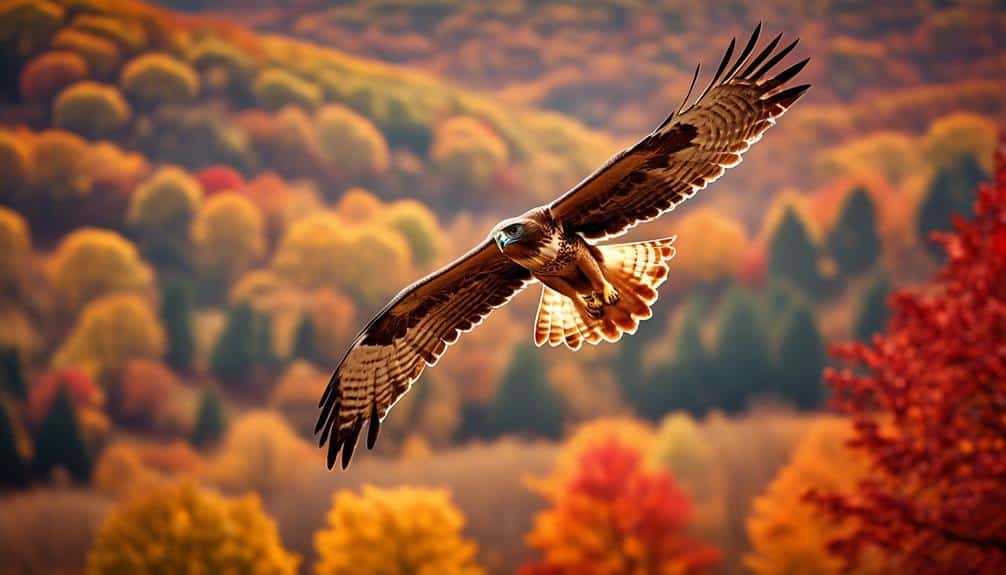
Having explored the remarkable adaptive behavior and hunting techniques of the great horned owl, let us now turn our attention to another majestic bird of prey found in Pennsylvania – the graceful red-tailed hawk. The red-tailed hawk, scientifically known as Buteo jamaicensis, is a large bird with a wingspan of up to four feet. Its name comes from the distinctive reddish-brown coloration of its tail feathers. This bird can be found throughout Pennsylvania, from woodlands and forests to open fields and grasslands. It has a preference for areas with high perches, such as tall trees or utility poles, which it uses for hunting and nesting.
The red-tailed hawk is a highly skilled hunter, employing various techniques to capture its prey. Its hunting style primarily involves soaring high above its hunting grounds, patiently scanning the landscape for movement. Once it spots its target, it will dive down at high speeds, using its sharp talons to snatch its prey. Although the red-tailed hawk primarily feeds on small mammals like rodents and rabbits, it is also known to prey on birds, reptiles, and even fish.
To give you a better understanding of the red-tailed hawk's habitat preferences and hunting techniques, here is a table that summarizes these key aspects:
| Aspect | Description |
|---|---|
| Habitat Preferences | Woodlands, forests, open fields, grasslands |
| Perching Locations | Tall trees, utility poles |
| Hunting Style | Soaring and scanning, diving at high speeds |
| Prey | Small mammals, birds, reptiles, fish |
The red-tailed hawk is a true marvel of nature, with its grace and hunting prowess. Its ability to adapt to various habitats and employ effective hunting techniques showcases its evolutionary success. The next time you find yourself outdoors in Pennsylvania, keep an eye out for this magnificent bird soaring through the skies.
The Powerful Osprey

The osprey, also known as Pandion haliaetus, is a formidable bird of prey found in Pennsylvania's waterways, known for its impressive hunting skills and unique adaptations.
As a master hunter, the osprey utilizes a variety of techniques to catch its prey. One of its most remarkable hunting techniques is its ability to hover in mid-air, scanning the water below for fish. Once it spots its target, the osprey plunges feet-first into the water, using its sharp talons to grasp the fish with incredible precision. It then takes flight, carrying the captured fish in its talons back to its nest.
Speaking of nests, the osprey has fascinating nesting habits. Unlike other birds of prey, the osprey builds its nest exclusively on man-made structures such as utility poles, channel markers, or nesting platforms. These nests are large and sturdy, typically made of sticks and lined with softer materials like moss or seaweed. The osprey is known for its fidelity to its nesting site, often returning to the same location year after year.
The Agile Cooper's Hawk
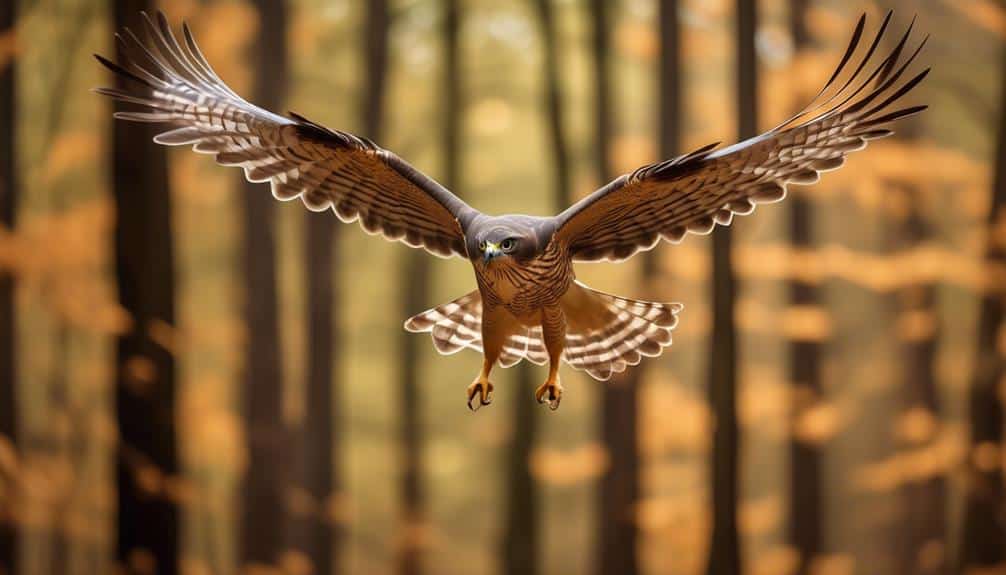
As I shift our focus to the agile Cooper's Hawk, I must highlight another impressive bird of prey that can be found in Pennsylvania's diverse ecosystem. The Cooper's Hawk, scientifically known as Accipiter cooperii, is a medium-sized hawk known for its remarkable agility and hunting prowess. This species is commonly found in woodlands, forests, and suburban areas throughout Pennsylvania.
Cooper's Hawks are known for their distinctive behaviors, especially when it comes to hunting. They possess incredible speed and maneuverability, allowing them to navigate through dense vegetation with ease. These hawks are adept at capturing prey mid-flight, often surprising their victims with sudden bursts of speed. Their diet primarily consists of small to medium-sized birds, but they're also known to feed on small mammals and reptiles.
When it comes to habitat, Cooper's Hawks prefer mature forests with a dense canopy cover. These areas provide them with suitable nesting sites and an ample supply of prey. They're also commonly found in suburban areas with tall trees, as they adapt well to human-altered environments.
Frequently Asked Questions
What Is the Average Wingspan of the Bald Eagle?
The average wingspan of the bald eagle is approximately 6 to 7 feet. This majestic bird is known for its impressive size and strength, making it a symbol of power and freedom.
How Many Eggs Does a Peregrine Falcon Typically Lay in a Year?
Peregrine falcons typically lay 3-4 eggs per year. Their breeding behavior involves courtship rituals and selection of suitable nesting sites. This high reproductive success contributes to the peregrine falcon's population growth and conservation efforts.
What Is the Lifespan of a Great Horned Owl in the Wild?
In the wild, the lifespan of a great horned owl can vary depending on several factors such as habitat, diet, and predation. It is important to study these factors to better understand the longevity of birds of prey.
How Fast Can a Red-Tailed Hawk Fly?
Red-tailed hawks are known for their impressive flight speed, reaching up to 120 miles per hour during hunting dives. They migrate long distances and use their keen eyesight and hunting techniques to catch prey.
What Are the Primary Threats to the Population of Ospreys in Pennsylvania?
Climate change impacts and conservation efforts are two key factors affecting the population of ospreys. Rising temperatures, habitat loss, and changes in prey availability pose significant threats to these birds, highlighting the importance of conservation measures.
Conclusion
In conclusion, Pennsylvania is home to a diverse array of magnificent birds of prey. From the majestic bald eagle soaring high above the treetops to the stealthy peregrine falcon diving with incredible speed, these birds captivate us with their strength and grace.
The wise great horned owl, the graceful red-tailed hawk, and the powerful osprey also contribute to the rich avian tapestry of the state. Just like the agile Cooper's hawk, these birds are a true force of nature, reminding us of the beauty and power that exists in the natural world.

